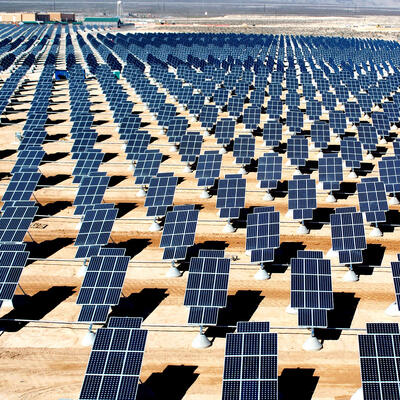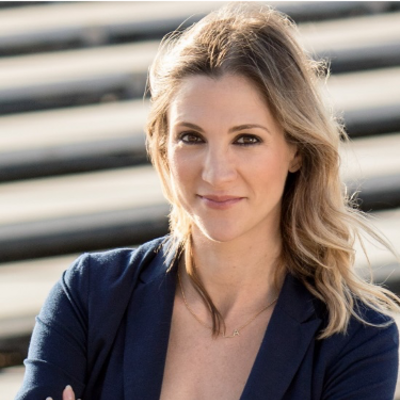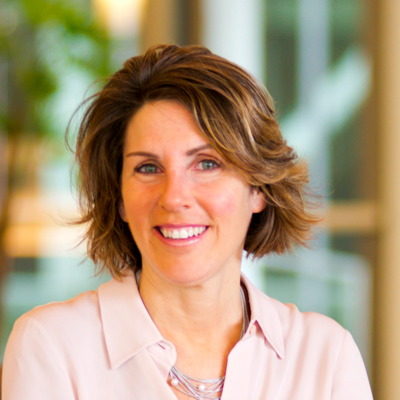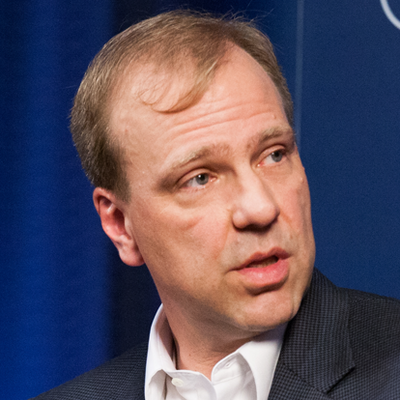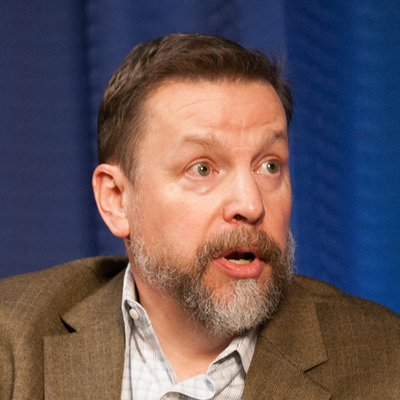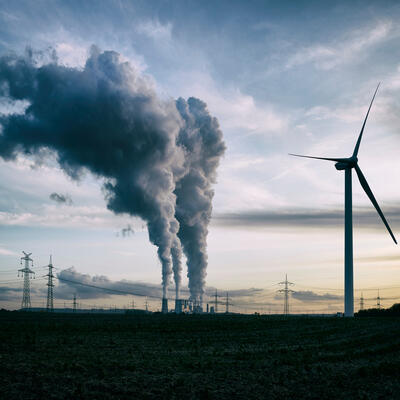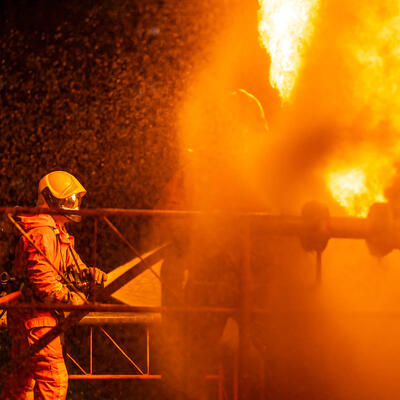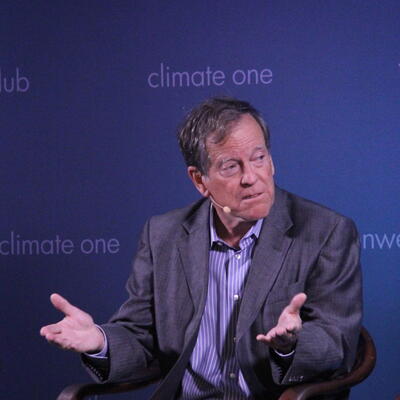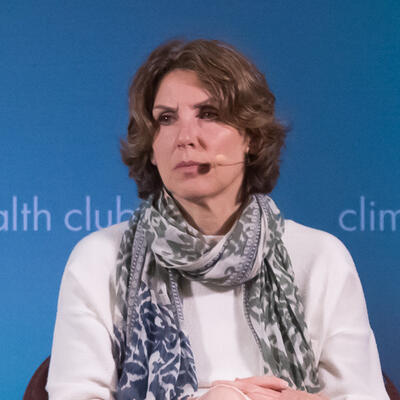Greg Dalton: Today on Climate One, we're looking back at the top energy and climate headlines of 2013. I'm Greg Dalton. Welcome everyone.
In the last 12 months, a lot has happened. The plug was pulled on a nuclear power plant and a growing number of Californians decided to plug in their cars. California's cap-and-trade program got up and running and Governor Brown inked several deals with other states and countries. Nationally, President Obama introduced his Climate Action Plan. Globally, energy markets grappled with the impacts of the boom in hydraulic fracturing or fracking for oil and natural gas.
Over the next hour, we'll talk about these stories and more with our live audience at the Commonwealth Club in San Francisco. We're pleased to be joined by four experts involved in shaping and covering California's energy future. Lauren Faber is West Coast Political Director at the Environmental Defense Fund; Amy Jaffe is Executive Director of Energy and Sustainability at UC Davis;
Andrew McAllister is commissioner of the California Energy Commission; and
Craig Miller is Science Editor at KQED. Please welcome them to Climate One.
[Applause]
Greg Dalton: I'd like to begin by kind of throwing the Lego on the ground and just see what we can make of it, and go down and ask you what you think are some of the top headlines energy stories of 2013, and then we'll talk about them, and we'll talk about both on the transportation side and the electricity side. Amy Jaffe, what are couple of the headlines of 2013?
Amy Jaffe: Well, I think the big events in 2013, of course, in the Middle East, is now the possible diplomatic deal between the United States and Iran. It might change the profile for the oil market over time. I think the air pollution story out of China is also going to be a big global — a game changer in terms of how that country moves forward and what that means for global climate policy.
And here in California, I think the beginning of the cap-and-trade program really is the whole world is watching to see is this a place that can make it successful integrating it with different regulations for power and vehicles. And if it's successful in California, I think that it would be a model that other countries are interested and the Chinese are interested or just in Beijing the Chinese are interested in how California forged a Clean Air Act and then move forward to other kinds of environmental policies. Europe is having a little bit of a breakdown of some of the cap-and-trade systems they put in place so they'll be interested to see what happens here.
Andrew McAllister: Yes. Well, I think I have more of a California focus. I really appreciate the global perspective. California is, again, in a position of leadership for reasons that you named a few of them. We have the electric system with some challenges. We have San Onofre off now and we know it's going to now stay off, so we need a plan for maintaining reliability and enhancing reliability.
Greg Dalton: That's the nuclear power plant San Onofre.
Andrew McAllister: That's the nuclear, the San Onofre nuclear generation station. And so that's, I think, enabling and forcing a discussion about how we maintain reliability at the same time we plan for a much lower carbon electricity future. At the same time, on the transportation side, we have a very active overlapping of the electricity sector and the transportation sector with electrification very much scaling up, still small but scaling up very quickly, electrification of the transportation system.
So between that and Governor Brown's leadership on the climate issue and really reaching out to other states and other nations, the West Coast, China and other places to provide California's leadership and contribution, I think these discussions really take on even greater urgency so everybody is watching what we're doing here in California and it's both an exciting and challenging time I think.
Greg Dalton: Lauren Faber, as a person working for one of the largest environmental organizations in the country, what do you see as the highlights of 2013?
Lauren Faber: Yes, thank you. As we look back in 2013, particularly I focus on California as well, though what California has been doing certainly has much wider implications, I really think of it as a marquee year for climate change and clean energy. As Amy touched on, this is the first year of the cap-and-trade program. And as what we've seen is now for the first time businesses in California are facing an explicit cost to emitting climate change pollution for the first time through a carbon price.
Now, businesses are faced with certain decisions that they weren't necessarily faced with as explicitly before and they're faced with as well a firm limit on the amount of emissions allowed into the system. That has never happened before. And so California is really now at the forefront of is this going to work?
After a full-year, we've seen a set of five auctions through the program but have collected and has collected over $500 million in proceeds and now that allows for a dialogue of what should we be doing with those funds? How should California be investing in a clean energy future to really further the goals of AB32? And ensure that communities are protected from the impacts of climate change and that all communities, including the most vulnerable communities, are directly benefitting from the program. So that is something that really is going to have much wider implications.
What we're seeing in the early days is that businesses are finding it reasonable to comply that the program has been functioning, the sky has not fallen. And I think that what we've also seen is the courts continue to grant California's side on the part of California when faced with challenges by opposition to AB32 as well as 2013 ushered in a new generation of legislators in Sacramento, a generation of new elected so we really didn't necessarily know where the chips would fall, where the power balance would fall on the environment. And despite some heavy industry lobbying throughout this year, it seems that the legislators really recognize the economic opportunity and the importance of protecting communities that they have green-lighted a series of programs that provide billions of dollars of incentives for clean energy in California.
Craig Miller: So headlines, fracking, fracking and fracking — I guess I would go with those three, which is interesting because this is something we didn't use to be a California story so much. This is something going out on the other side of the country or up in the upper Midwest. But now that there's talk of a possible boom in the so-called Monterey shale, this huge deposit that extends all the way from Monterey County down deep into the San Joaquin Valley and all of the oil, not gas, that might reside there, might be recoverable. Fear of fracking is rampant.
And so it seems like the environmental discussion at California and the energy discussion, there's been a big shift towards that as they try to develop regulations and figure out how we're going to keep a handle on that. Also interesting I think was this birthing process of the nation's first most comprehensive, I guess is the best way to put it, cap-and-trade program and also how we're going to manage all of these renewable sources of energy that are developing pretty rapidly and get them integrated onto the electrical grid, which is not a trivial matter.
Greg Dalton: Let's pick up on that central tension of California being a green leader as we've heard and California potentially being on the verge of a boom in supply of fossil fuels. Can California do both? Is there a contradiction in that?
Andrew McAllister, you're an energy commissioner, I mean can California be green and brown at the same time?
Andrew McAllister: So we have carbon content goals for the state and they're fairly aggressive. So you actually look at it from that perspective, the renewable portfolio standard and limiting the conversation for now to the electric sector where if you count the molecules, we don't have a lot of room for scaling up a fossil-based generation without bringing out and I'll caveat that with saying without bringing on some form of carbon sequestration. If we're going to burn the stuff or we're going to use it to generate electricity, we need to do something with the carbon other than emit into the air or we're not going to meet our renewable portfolio standard or we're not going to meet our common carbon content standard goals for the long term. So there's a question of sort of we can get there for 2030, getting there for 2050 is now require a heavier lift and those are much, much deeper goals.
But certainly the issue of fracking, I think California, from my perspective, is taking a cautious but I think balanced approach in that. The legislation that recently passed requires the Department of Oil, Gas, and Geothermal Resources to develop regulations to essentially require reporting and monitoring for any sort of fracking-related drilling that goes on and it gives voice to some of the communities in those places. So I absolutely agree that while there are lots of questions about what's actually there and how much is recoverable and what that play actually looks like.
And by play sort of the Monterey shale resource, it's not going to look like Pennsylvania or others parts of the U.S., it's really going to be its own thing and it still has a lot of questions associated with it. But certainly California has not said no to exploiting that resource but wants to do it in a responsible way and that's what regulations and the regulatory process are for to make sure that we get to a point that essentially works with our robust democracy and our democratic process in California to get to a point that basically satisfies the stakeholders but doesn't completely take it off the table but does it in a way that's responsible.
Greg Dalton: Amy Jaffe, you came recently from Texas. You're an oil and gas expert. How do you see California's ambitions as a clean and green state with all of its potential oil underneath our ground?
Amy Jaffe: Well, we have a tension here in California because we're also a state with lots and lots of automobiles, and we're transitioning to do a few or other kinds of technologies EVs. We have the aspiration of go to hydrogen. But the bottom line is right now we all have vehicles that run mostly on oil-based fuel.
So the challenge we have is how to moderate meeting the needs we have with our current vehicles but still maintaining a pathway forward to transition to something cleaner and that's going to be a bit of a challenge. It's a challenge because we have the incumbent infrastructure of gasoline stations and those are readily available. We all have range anxiety if we're going to use something other than gasoline. And getting the public to shift over, just in their thinking, is a big challenge.
Now, in terms of the shale in the state, I think the people need to understand that every geological shale play is different and actually there's some place that aren't even the shale level but maybe some other formation under the ground and it requires different experimental technology. Fracking has become this universal word but actually has a technical meaning. The technical meaning is I'm going to take water and I'm going to put it – shoot it underground at very high pressure to create small, tiny fissures in rocks way under the ground and then I'm going to put small particles of sand or some other kind of propend to hold those tiny little cracks open so the oil or gas can flow back up the engineering-designed well.
Now, we've been doing that with vertical wells for decades and decades, and now the change is that we're able to do it with horizontal wells as well. But those technologies that have been tried in the Monterey have not been terribly successful and the companies here are having a lot of difficulty. So, even when you hear representatives from the oil industry say that it's the environmental regulation and all those stuff that's holding them back, my opinion is that is not actually what's holding them back. What's holding them back is they haven't actually quite cracked well the puzzle for how to technically produce the stuff here in California.
And because everybody understands well the shales that are being done in Texas in the South Eagle Ford and soon in the Western Texas and a play you're going to hear more and more about one called the Wolf Camp because it can be done there easily. People understand the geology and it can be produced at a fairly inexpensive rate compared to the current price of oil. It's going to look like all the investment dollars are going to Texas because Texas is a place that understands it's not good to regulate industry. But that's not really it.
The bottom line is if you could come into California and know how to do the Monterey and have it be highly producible, people figure out how to do it. But I think that we really do need to ask ourselves because any drilling, even geothermal drilling, any drilling that involves having a cement casing and you're going to put chemicals under the ground, right? And here in the state of California, by the way, we don't do a lot of fracking with water. We actually use acid and other kinds of things to do the fracking, right?
Any time I'm going to use a production system where I'm counting on steel and cement not to fail, there's going to be some proportion of challenge and I think we have to ask ourselves, "Are there places in this day where we just don't want to have drilling, right?" And I think there are places, for example, in New York, there's still a lot of debate but I think the debate is clearly over. There's not going to be oil drilling in places that are connected to the New York City water table in any kind of way possible. There needs to be sort of like a safety fence of where there's going to be drilling in New York related to so many millions of people being dependent on drinking water.
And here in the state where we have places where agriculture is so important, right, I think we really need to be wise and it doesn't matter what they're doing in Ohio or Pennsylvania or Texas, a lot of agriculture in Texas and some of it's happening safely onshore. But here in the state where we put such a high value on certain kinds of industries and certain kinds of recreation, we probably do want to think carefully about where do we already have a lot of industry, where we might as well continue to drill there in the safe and sound way, and other places where we really actually don't want the industry to extend into.
Greg Dalton: As a former Texan, you went native pretty quickly here in California.
Amy Jaffe: No, no. I used to say this in Texas too. Let me tell you something. For those of you in California listening and for my former friends who say, “Why did you move to California from Texas, right?” We have this idea and this contrary that it's okay to have poor air quality for children growing up in Houston and that it's okay to have water get contaminated in Texas, right? Or have offshore accidents that damage beaches in Texas that that's okay because it's in Texas, right?
But I can tell you, as a person who lives in Texas, even for the people who feel it's okay in Texas, for those of us who raised their children in Texas on how to deal with asthma and how to deal with other consequences, it's not okay for 250 million cars to drive around the United States leaving all the pollution in Texas and feel that's okay, right? That was never okay. So what we really need to do is have policies that limit or limit the inconvenience and the polluting effects of using this fuel until we can transfer to something else. And we have to be realistic about how long it's going to take us to transfer to something else because it can't be done overnight because we have 250 million liquid cars on the road.
Greg Dalton: Let's talk about electric cars. And one of the key stories of 2013, Tesla, if you ask me a year ago, I thought Tesla, I'm not sure they would have made it. Their stock is up 400 percent. This year they made electric cars sexy. They're an example of getting off of fossil fuel based cars, at least dependent, if you don't live in a coal state.
Craig Miller, tell us about broadly about the impact of Tesla this year as a story?
Craig Miller: Well, Tesla, I think, is a symbol of where we can go with electric car technology. Obviously, it's going to be a blend of all electric cars, plug-in electric cars, hydrogen fuel cell cars. If you went to the L.A. auto show this year, was a surprising number of new introductions or future introductions with hydrogen fuel cells. A lot of people thought that technology was dead. Now it seems like it's getting a second wind and Arnold's hydrogen highway may actually happen after all.
Greg Dalton: It's coming back.
Craig Miller: Yes, right, he'll be back. But we have a long, long way to go. Jeff Greenblatt at Lawrence Berkeley National Laboratory put out a very interesting study recently about what it would take, actually take, to achieve California's 2050 greenhouse gas emissions goal of 80 percent reduction.
And it would — he thinks we'd have to basically electrify about half. We'd have to get – he said we would have to have about 50 percent renewable electricity sources in order to get there and 80 percent or 90 percent of the transportation fleet would have to be either electrified or some other form of zero emissions vehicle. This is a huge, huge task compared to where we are now.
The state has just gone into a coalition with seven other states to try to get 3.3 million zero-emissions vehicles on the road by 2025, I think it is. And even that, when you look at that, even though that those eight states control about a quarter of the automotive market in California, there's a huge replacement market out there. There's all these cars that are on the road and are going to continue to be on the road and they still were in gas. So it's a long road ahead.
Greg Dalton: Lauren Faber, you also were at the Los Angeles auto show. Hydrogen is back.
Lauren Faber: Yes. It was really my first time at the auto show actually. So I went down to L.A. a little early for Thanksgiving and went around to a bunch of the different car companies were showcasing specifically their hybrids, their plug-in electrics and then I stopped over at Hyundai to see their hydrogen fuel cell SUV. And they were touting a recent law passed in California that was going to enable an increase in these types of vehicles by increasing fueling station across California. There were a series of cars that were being marketed across a number of different — towards a number of different sectors not just young and not just excessively wealthy as well but this could be primary cars for individuals. But it does beg a question of how do you then integrate these cars if we really are going to get where we need to go, how do you integrate these cars into the grid?
There's a lot of work being done in California to modernize the grid to be able to upgrade it, to take advantage of the fact that rate payers spent millions of dollars, if not more, putting in smart meters and so what are we going to use that for and that's really at a place that we're going to be next year. 2014 is a moment where not only are we discussing how we replace lost capacity from the nuclear generating station, but if we really are going to support in increase in plug-in electric vehicles. So this is going to be a very exciting year for that but it requires the utilities, for example, to really be thinking of that new business model. I know that Commissioner McAllister thinks about this a lot in his day job and the IPA report that is coming out is going to be talking about that as well.
As far as the LBNL study, the Lawrence Berkeley National Lab study on what California needs to do, to me the 2050 goal, is anything that sort of reaffirm to what we already know, which is that we are on track to meet our current existing required targets and that we need to extend the programs that we have both in the electricity sector and in the transportation sector in order to continue meeting.
Andrew McAllister: We're on track to meet the 2020 target but we don't know if we're on track really to meet the 2050 target. I mean even the air board has come out recently and said, "We have no idea how to make policy for 2050. It's just too far away." We need a midterm goal like around 2030, something that we can actually like formulate policy around because there's some idea what the technology is going to be then.
Lauren Faber: And that's a really exciting place for us to be. That means that we are sort of from here to 2020 assume this program is in place, we are going to reach our targets. But in order to be serious about 2050, now is the time to actually start talking about a midterm target around the time of 2030 so that's going to be a very exciting time in California in the year to come.
Greg Dalton: Let's talk about these other states because California was linking arms with New Mexico and other states. Those other states had elections and the governors have run the other direction. California has stayed the course. What's the importance of some of the things that happened in the last couple of months with linking up with Quebec, with the other West Coast states and British Columbia?
Andrew McAllister, what's that going to do for California?
Andrew McAllister: Well, so I want to go on something that Lauren and Craig just said, which in the transportation sector and just generally with our long-term carbon reduction goals. I think that there are a number of agencies that work on this and we won't get in the alphabet soup here. But the Air Resources Board is the primary agency responsible for implementing Assembly Bill 32, which is sort of the umbrella legislation that's enabling a bunch of different offspring legislation as well.
Greg Dalton: California has made climate law.
Andrew McAllister: Made climate law here in California. But as a policy matter, for example, with transportation, there are lots of technologies and we're not in the business of picking the winners, we're in the business of enabling the marketplace. And I think it's very important to acknowledge that and to build partnerships with the various manufacturers, industry players, local jurisdictions, all of this up and down sort of food chain of the decision to understand what customers, what consumers want and try to develop policy that pushes that, that pin holds that very well. So we have, on the one hand, we have hydrogen fuel cells –
Greg Dalton: And who wants hydrogen?
Greg Dalton: Go ahead. I mean –
Greg Dalton: It takes a lot of energy to make. There's no infrastructure.
Andrew McAllister: Well, so it has a network issue. It has all sorts of challenges. There's no question about that. But if you are serious about counting the carbon molecules, you do need, as Amy said, you need a non-fossil alternative that can potentially check off all the boxes that consumers want, right? And it's not clear which batch of technologies or which percentage of all the ingredients to make the soup is going to really be the one that wins out.
And so the policy decision across all the agencies has been to enable as many as we can that look promising, and certainly fuel cells are on the front end than earlier mode as far as what you would call market transformation. Electrics are further down the road. Tesla's business model started out 12, 13, 14 years ago developing IP. They'll start with a high-end and a sports car market and then move it mainstream, and they've really been rigorous, I think, about following that business model and it's kind of paying off now. There certainly questions but the electrics are further down the road. They need to scale up progressively still. We don't know what that's going to look like but I think the point is that we have a bunch of eggs and we have a bunch of baskets and that's not a bad place to be at this moment, right?
So that policy environment, here in California, is fairly well fleshed out that we have several important agencies working together, not only on the transportation front but also on the electrical reliability front. We are moving towards a distributed generation. We're moving towards large-scale renewables to meet the RPS goals. We have challenges with San Onofre nuclear generation station being off. Beyond that, we have a bunch of once-through cooled power plants that are going to be — their licenses are essentially going to be expiring and we're going to have to make decisions about whether and which of those facilities to repower with generally natural gas. So there are a lot of challenges coming up that are forcing this discussion now.
And as Lauren said, it's really this is the moment that if we're going to really chart the course towards this low-carbon future, we can make infrastructure investment decisions now that will be with us for a while. And so we're doing that in California and I think a lot of the West Coast states and other states across the west are looking at us to see what we do. And Pacific Coast collaborative is a place where it actually includes British Columbia and then Oregon, Washington, California just signed a pact to really focus and hold hands on the long-term climate imperative.
So I think that's very important to send a message to the rest of the country and even globally across the pacific that we now have a block, not just California, we actually have political commitment at the highest levels to take climate seriously and to proactively develop the kinds of solutions that we're all going to need.
Greg Dalton: Craig Miller is that more than a political photo op for the governors? Is there real substance there in this West Coast thing?
Craig Miller: It depends on which one you're talking, but there's been several initiatives. But if you're talking about the new Pacific Coast initiatives that includes British Columbia as well, basically the entire West Coast, Oregon, Washington that came together to try to kind of get on the same page at least, I think there's real good intent there. The problem is that the plan is I think about a mile wide and about an inch deep. It's kind of all over the map in terms of the different measures that things that we would try to do, targets it would set, programs it would put in place but there's no mechanism to fund it specifically.
There's nothing legally binding about it. It's all just because we happen to have friendly governors in office right now. One change like we saw in Arizona or New Mexico could change the game dramatically and it's pretty much left up to each individual state. Even if they go about sinking up their emissions targets in this area or that area, it's kind of up to each state how they're going to get there. So there's a lot. To me, the jury is still out on whether there's real substance there.
Andrew McAllister: Sorry just to say that that's true that the states are ultimately responsible for what they do within the states and part of this is a response to lack of federal leadership. We really — we're having to go down this route because there's not a federal climate policy.
Craig Miller: And to quote Governor Brown in one of our interviews, he said, "This is a really big deal," meaning this new initiative and, "If people want to pretend it's not, they don't know what the hell they're talking about." So –
Lauren Faber: Well, I knew it. I mean there will always be elections. There will always be the chance that any policy from a conservative or from a democrat, are going to be undone by their successor.
Lauren Faber: So that is always something. That doesn't mean that the person in power should not be doing everything he or she can to be promoting and installing some of the most ambitious policies on climate change and clean energy as possible. So the fact that we have that up and down the West Coast is an amazing opportunity. And the fact that Governor Brown and the other governors are taking advantage of it and not letting it slip by them is very important. I would say –
Amy Jaffe: But it has to be — listen, it has to be –
Greg Dalton: Amy Jaffe?
Amy Jaffe: It has to be market realistic and we see that with the Renewable Fuel Standard for the federal standard, right, where we have this pipe dream about how much fuel was going to be ought to be produced –
Amy Jaffe: — from cellulosic materials –
Amy Jaffe: Yes, really. And in the end, we didn't make it. And now we have this huge dislocation with the EPA having to keep rescinding, rescinding on these targets.
Greg Dalton: This is about corn blended with gasoline that they're going –
Amy Jaffe: Correct.
Greg Dalton: Okay.
Amy Jaffe: Right. So we're not going to be able to get beyond the 10 percent that we were doing with corn-based ethanol. It's not. I think the state here in California is also going to have difficulty meeting biofuels targets. A lot of money has been put into this field and it's not really producing what was expected in the time frame that was expected. And there are some interesting, promising things that might happen over time because the oil sector is moving towards having a surplus of natural gas in the United States. It's opening the opportunity to put natural gas in heavy trucking and the marine, right, which has a –
Amy Jaffe: Right, which has an immediate air pollution benefit. But what it means is if the infrastructure for that fueling goes in place, then someday one could gasify biomass and possibly put gaseous form biomass into vehicle transportation.
Greg Dalton: Amy Jaffe, I want to ask you about
Andrew McAllister mentioned lack of federal leadership. President Obama this year, 2013, we're talking about energy highlights at Climate One, came out with a climate plan, what grade would you give the president's climate plan?
Amy Jaffe: I think the president's climate plan is pretty weak and I think that part of it has to do with here in the state of California, people are willing to put up with a high level of inconvenience because they have a commitment to environmental causes. But that is not the norm around the United States and people are waiting for some technology to fall out of the sky. We want Elon Musk and his group to just come up with doohickey, "We're going to use it." And then the problem is going to be completely solved and we're not looking for what we are going to do as individuals. And you can have a smart meter in your house but if you're plugging in your car at 6:00 p.m., on peak, you're not going to do anything to help the fact that you have a smart meter, right?
So you're going to know that you're spending extra for electricity and putting a burden on the grid, it doesn't help if you have a range anxiety, right? So some of it is behavioral based and that is why I think it's hard to make a federal policy and it's hard to make a federal policy that will go quickly.
Now, the one thing that I can't really say, well, the president supported, right, was this idea of having regulations that mean that our cars need to get higher fuel efficiency, right? And this is going sort of better than expected. It's a very strong tool. Any kind of tool that actually lowers your use of fossil fuels is a better tool than hoping that people are going to spring eternal because even switching to an EV is not useful if you're trying to eliminate natural gas demand if all your electricity is being generated with natural gas, which a lot of the states, electricity is being generated with natural gas.
So we have to be realistic. I have a little optimism because I'm a university professor and I deal with 18-year-olds all day, right? And the millennial generation is much more willing to the shared economy. So in the shared economy, I don't actually have to have a car because I can either share a car or zip car or not even use a car and I might be willing to walk. I might be willing to do everything in such a distance that I'm going to live urbanely densely and I'm not going to need as much energy to do it. But with all due respect to this generation, they have a lot of gadgets to plug in.
Greg Dalton: They do. I want to get you also on the toxic politics of energy. You mentioned that when politicians, two-party politicians and others make comments about energy, how that affects the politics of energy in America?
Amy Jaffe: Let me talk about that. There's a great business scholar at the business school at UC Davis, Don Palmer, and he's written an award-winning book on called Accidental Wrongdoing, right? So how do we wind up with accidents like the Macondo or challenges or corporate challenges where we find out corruption or made off and some of this, Wall Street scandals, how do we wind up with that? And one of the things that the academic research shows is that when entities get in a competitive relationship with state agencies. And by state agencies, I mean it could be the federal government, it could be the state government, it causes people into this sort of accidental momentum. So if you think about it, it makes sense. So I believe in Texas and other states you get this face the father petition calling on the states to defang the EPA's overregulation of shale production.
Greg Dalton: Well, Governor Perry in Texas called for abolishing the EPA.
Amy Jaffe: He'd like to abolish the EPA. Now here's how this goes, okay? So now I work for a company and I have a — take a company like Chevron that's putting this huge program for high reliability training, right? But the governor of Texas, like all his employees in Texas, the governor of Texas is saying, "We should abolish the EPA," and he's trying to defang the Texas EPA, right? So now I'm an executive in an oil company and I'm telling my staff to make sure they follow all these EPA regs and do everything very carefully. And they second-guess it now because politicians are telling them that the EPA is stupid, and we know technically better how to do this. We know it's safe, right?
So now I'm not even willing to listen to the health and safety experts from my own company. Now I think that I, the guy turning the widget, I know better about what's safe and not safe, and what's necessary and not necessary than everybody. So I do something wrong and we have an accident. And this pattern where we decide that there's some competition between jobs and environmental protection, this is a stupid idea. This is why we keep having accidents, right?
And we need to get out of this competitive political framework where somehow the social good is anti-jobs, right? Because that's not really true, right? It's not really true. You have to have proper regulation of markets otherwise you have financial crisis that kill jobs. If the American car industry had accepted these higher CAFÉ standards in 2001, after September 11, when it would have been politically expedient to have done it instead of sending lobbyist against it, they wouldn't have lost all those sales in 2007 and 2008 that caused the bankruptcies that caused all the jobs to be lost in the first place.
So there's this messaging that comes out of Washington that's not helpful and we, the public, are smarter than this. We need to stand up and say, "We care about both things and we want it to be done in a way that both things are protected.
Greg Dalton: Amy Jaffe is Executive Director of the Energy and Sustainability program at UC Davis. Our other guests today at Climate One are
Craig Miller, Science Editor at KQED; Lauren Faber from the Environmental Defense Fund; and
Andrew McAllister, Commissioner on the California Energy Commission. I'm Greg Dalton.
We have not talked about water. We're going to get to our audience questions in just a little bit.
Craig Miller, this could be one of the driest years on record in California. Water and energy are very connected. What are some of the big water stories, if any, of 2013?
Craig Miller: Well, I think a lot — there's been a lot of water anxiety lately because last year was dry. The year before that, we did a nice job of filling up the reservoirs but now we pretty much used that. There isn't this what they call carryover storage that we depend on that's from the snowpack, which provides so much of the state's water to get us through the dry summers. And if we have another really dry winter all the way through, and so far we are, there's going to be some real anxiety come spring.
And when this happens, it affects not only just the water supply per se but it also affects energy and it affects what we pay for energy. There was a study done by the Pacific Institute, for example, that the last three-year drought we had, utilities all of a sudden the hydropower wasn't there that they were counting on. And about 12 percent of the electricity in California comes from some kind of hydropower but they had to substitute so much natural gas to make up for that lost energy that it ended up, according to Pacific Institute, costing people in sum about more than a billion dollars in extra utility electricity cost during that period.
So there's some real implications and also to the degree that power plants have traditionally used water to cool themselves. That's changing too. The landscape is changing there, bringing up some real concerns about what they now call this water energy nexus.
Andrew McAllister: Yes, so a couple of comments. So those are great points and I'll just add to that, that on the demand side, so this is Climate One discussion, right? So on the demand side, climate also has big impacts and as we in California we accept the climate science we really don't have any issues with the knowledge that it is coming and we will see changes. If you're in the Inland Empire down at Riverside County or in San Bernardino or someplace where the weather is going to get more extreme, it's going to also affect demand side. You got more air conditioning load and you're going to have a lot more demands on the power system. So that's one.
And the other thing I wanted to say just has to do with the long-term impacts of climate on just not having as much snow up in the mountains and it's the timing of the runoff. So demand is now no longer going to mesh with when we have the resources as well so that is also a stress on the electricity system a bit large. And so I think, again, we go back to the need to have this conversation for long-term planning, get the agencies, that's the California independent system operator, the energy commission, the public utilities commission really working together with a long-term strategy looking towards 2050.
And again I think we're in a moment right now where we really do have very good policy alignment across the agencies and with our elected officials and it's an opportunity to get some of the stuff right, to have a fairly deep conversations that's happening and that's why I'm very encouraged. And this is in very sharp contrast to the federal situation that Amy just talked about and not that it's perfect in California by any stretch, but I think we're having the conversations and we're at least not in denial.
Greg Dalton: San Diego recently approved a $3 billion project over 30 years for a desalination plant to desalinate water so this is a water energy connection. Is California ready for more desalination plants, which use a lot of electricity? Andrew?
Andrew McAllister: Until recently lived in San Diego and definitely I was not involved directly in that project but certainly aware of it. Desalination takes a lot of electricity and it just so happens that the site for that desalination plant is right there next to an existing power plant and that's not an accident. Part of it was right of way and sort of land availability, but part of it was reliable power to actually run the reverse osmosis.
So I think it remains to be seen. The water I do not purport to be an expert on water economics and it gets quite complicated and it's certainly not a full market based system. But I do think that a lot of folks up and down the West Coast certainly are looking at that plant in Carlsbad and sort of waiting to see how it pans out. And I know the city is quite committed to it and whether consumers are willing to sort of go down that route and see water cost increases, I think, remains to be seen.
But we are going to have a supply problem. We have to figure out either on the remand side or on the supply side get ourselves enough water. The demand side is also a resource as it is in energy. So if you can reduce demand, that's really the cheapest and the best thing you can do but there's a big infrastructure system that we have to make the right investments in and a lot of people are looking at that desal plant to see if that's one of the right ones.
Greg Dalton: Amy Jaffe, you had a paper out recently about unburnable carbon and the impact of the so-called carbon trouble on the stock prices of fossil fuel companies. Tell us what the conclusion was.
Amy Jaffe: Well, so we just published the paper today and what we found was that there's already been $27 billion lost that came off the stock back in 2009 when the first two-degree science articles came out. And so –
Greg Dalton: An article on the Scientific Journal saying the world should not go beyond two degree Celsius of total warming since the industrial era began.
Amy Jaffe: Correct. So some later analysts have — and even in some later articles — they've assessed that some high proportion of the fossil fuels that are in the balance sheets of different companies and some of them are national oil companies and some of them are the sort of household name companies that were used to the Exxon Mobil and so forth. Some people predicted 50 percent or more of the carbon that's involved in these. Fossil fuel assets are not going to be able to be burned.
And the question is, has the market taken that into account or not? And we did an extensive search looking at how news reports, and discussions, and pension fund, and investor activism has affected the stocks of the American oil companies. And I think one of the things we found was that when investors look at the full gamut of the value of these companies, they also take into account more complex stories than just the unburnable carbon story. Because, of course, you've got companies like Chevron and Shell that have new carbon sequestration and storage projects for their oil sands fields in Canada and for their giant Gorgon project in Australia. And the economics of those carbon sequestration technologies is it's expensive, but when you take it over the 30-year life of an investment in fossil fuels, it's really not that burdensome. I mean it's burdensome but not enough to make the company completely unprofitable.
So the point is that I think the markets have cleared this idea that there's going to be some use of renewables in people's businesses. There's going to be some companies that will shift more heavily to natural gas because that has a lot less carbon content than oil. So a mix of things I think are in the market and that is why this sort of scare story that we're going to have this crisis and the value of these stocks is probably incorrect.
Greg Dalton: We had John Hofmeister, former president of Shell Oil, here a few months ago. He said that, "A lot of the carbon would stay in the ground. It would not get burned. The stocks would be flat to down." That's basically a bet that there won't be real serious policy that's going to really keep the carbon in the ground. Is that right?
Amy Jaffe: Well, I think if the companies are betting on there not being really serious policy to keep the carbon in the ground, there, I think, they're incorrect. And I think that here in California, we've been a little lucky in terms of hurricanes and those kinds of natural disasters but you can hear from my accent that I'm originally from the East Coast. And the impact of Hurricane Sandy was really pretty dramatic and the impact of the hurricanes we've had in the Gulf Coast, Rita and Katrina and the subsequent Ike and those hurricanes, really had a big impact on how people think about resilience.
So resilience of electricity, resilience of the fuel system, it's not acceptable to have fuel companies make announcements every hour that, "Yes, it's going to be another two weeks before anybody will be able to use their vehicles because we don’t have the electricity or the logistics to get you your fuel." Like those kinds of systems are not going to be accepted by the public and we're going to have more and more need for resilient infrastructure because the climate change is going to worsen over time.
And as it worsens over time, I think the political climate is really going to change and you can see it's starting to happen in these places that have been hit with these disasters. And in the end, right, if you really think about Silicon Valley and the improvements in the technologies for distributed energy which is I'm going to — you have my own little power source on my site, whether I'm going to store electricity but I'm going to generate my own electricity, whether it's with the fuel cell or some other kind of generation, maybe renewable energy like solar coupled with something, maybe traditional diesel generation, whatever it is, the reason these companies — this is the irony of the oil industry.
The reason these companies had to go to distribute energy is because the traditional utilities and energy companies were not able to supply them with reliable electricity and they can't have the chips — have to be cooled, right? And the servers can't go down. And so people had to go to these technologies. But once we have these technologies, very superior technology, you don't go back who's walking around now with a phone that's just a telephone? Nobody, right? You're not going to go back. I mean once somebody forces you to go to a smart phone, if that happens to you, like in my place of business, with things I had to do.
So my point to you is once you've used the superior technology, you're going to stick with it. Once people see, as they did in New Jersey, the towns that had their own generation systems, whether it was because they had some advance green power plant or whether it's just by accident they had their own power station, those towns got their electricity back in a day or two days, right? The people who are on the centralized grid, two weeks, three weeks into the process, they're still without electricity, without heat. So I think that they're going to be — the changes are going to be forced on us by the severe consequences of climate change.
And as those become more apparent over time, the public will become more conducive to a stronger climate policy and you're seeing that in China. I mean that is the irony. You’re seeing it in China where people are really suffering, where in cities in China you cannot go on site where the impact of floods and natural disasters is having a huge toll, right? And now the stability of the Chinese government is at more risk from environmental consequence than it is from even the traditional things like repression and the other things that people have thought might bring that government down. They are so concerned. Environmental issues are an emergency today in China.
And here in the United States, we're a step ahead in terms of Clean Air Act and some of the other legislation that we've put forward, especially here in California. But in the end, we do not have a resilient fuel system and the need for resilient fuel system is what's going to get us to the right kind of climate legislation.
Greg Dalton: Amy Jaffe is Executive Director of Energy and Sustainability at UC Davis. We're going to pause to include your audience questions. The line starts over here. If you're on this side, we ask you to please go through that door. Come up and join us with that one-part question and I'm here to help you with that. Let's go to audience questions. Welcome to Climate One.
Male Participant: Hi. I have this fantasy that not much is going to happen until Elon Musk wins the Indy 500 with an electric vehicle and I think that will eliminate 60 percent to 70 percent of the resistance to going toward. The future is not oil. The future is sustainable energy. We all know that. We're just having trouble convincing the Southeastern United States and the Central Valley.
So what do you think about that idea, and do any of you know Elon Musk and get him started? I mean if he can go to space and back, he can certainly put a race car together that can take the Indy 500, and that will change Texas and that will change the Southeastern United States.
Greg Dalton: Amy Jaffe?
Amy Jaffe: The problem is Americans have range anxiety. The problem is not the performance of the car, the performance of these cars, even not the Tesla, the performance of the other, the Ford cars and the Volt and everything, their performance is outstanding, right?
Craig Miller: That eight-second pit stop at Indy becomes very challenging when you have to plug it in and to wait for it.
Greg Dalton: Yes.
Amy Jaffe: No.
Greg Dalton: Well, electric cars no one ever talks about this. Electric cars are more fun to drive. I drive a Leaf. It's pure electric. It is more fun than a gasoline car is. Zippy, there are range issues but they are fun and they are fast and they are cool. Lauren Faber?
Lauren Faber: I think there's a lot that pop culture can do to — a lot that they can do to sort of, yes, on the messaging side but also just on getting people to learn more about it. It sort of permeates culture a little bit more widely. But at the same time there still are some roadblocks for folks, whether it's the anxiety part but also in some ways the cost.
Right now, there are a series of programs and incentives to kind of help get some of those early technologies kind of over initial humps. And as you get those early adapters, a lot of that then helps permeate into pop culture. Your friend has one and you know someone who has one and it continues from there. But I think some combo of really introducing it into pop culture with some programs and incentives like a number of them exist in California do help some of those early vehicles to get over the hump.
Craig Miller: I think that the performance case for electric or hybrid electric vehicles has pretty much been made. Right now, I think it does come down to largely a matter of cost, by and largely they do cost more still. That will change.
And if you look at some of the more recent polling from like the Public Policy Institute of California, for instance, when they go out and ask people, "For your next car, would you be inclined to buy an electric or a hybrid vehicle?" A surprising proportion of them say yes and seriously considering that.
Greg Dalton: Amy Jaffe?
Amy Jaffe: So I think one of the interesting things that we have found at the Institute of Transportation Studies is once people have the car, there's this other problem which is what are the norms of using this car? So we all know when we go to the gasoline station, you have to stay in your car and line if you're waiting for fuel and you had to wait your turn in your car. But if I plug in my car and I go into the grocery store, and somebody comes up and I'm already charged and you unplug me, right? What's the etiquette that goes with plugging and unplugging in public stations? And that has not been worked out. So we here in the state of California are real pioneers on that regard.
Amy Jaffe: Yeah, absolutely. And –
Lauren Faber: Park and ride etiquette can be formed organically. I think this one can do.
Amy Jaffe: Right. So this is an interim challenge but definitely something that, again, sort of a hump that has to be gotten off with new technology.
Greg Dalton: I'll confess I have unplugged the other people once they are fully charged.
Andrew McAllister: So I just want to make the broader points at. This messaging is absolutely critical. I mean the iPhone wasn't done by a policy mandate, right? It was done by some innovative — it was done by a whole chain of concert, concerted activity, group of activities, a portfolio of activities, if you will, none of which, in that case, was policy driven.
In energy, it's a little bit different because we have high — it's high capital cost. This is big money infrastructure and this does require a policy consistency over time. I would argue that California voters have laid a nice foundation for having that policy consistency by voting over and over again for environmental policies that enable us to project to the private businesses that actually are the marketplace that we're not going to change course 180 degrees. We're going to basically move in that direction.
But it is, I think, really important to have policy and the broader marketplace, private business, profit motive beyond the same page about where we're going but the capital is largely going to come from the private sector that the state itself doesn't have. Now we can kind of prime the pump with incentive programs and statutory mandates and things like that. But basically, the big investment has to come from the private sector and so those two things have to see things similarly, at least, in order to have that consistency and get those investments made.
And then if does resolve in company winning the Indy 500, then that could be huge. I would say things like if you walk into your neighbor's house and they've done an energy efficiency upgrade at their house and they've reduced their energy consumption by 80 percent. And it's quiet in there, it's comfortable, there's no draft and they have all LED lighting and you realize how wonderful it is and that personal experience is something that policy can't make happen. It can encourage it but it is you and the social relation that you have with your neighbor when you go over for a dinner, whatever it is, that helps change the culture and involve us in that direction.
And so those, we can't underestimate. It sounds odd for a policymaker or a regulator to be talking about this but it is. This is the kind of cultural shift that we need that I think of its going to happen anywhere in the U.S., it's going to happen in California. But certainly, this is the kind of cultural shift that once we have the technology and the business model, the sort of the things that have to be there, it just doesn't matter of course, then we need those social processes to sort of finish the job and get the market transformed so that normal people, like you and I, when we're going to do a kitchen upgrade that we opt into doing the full upgrade of our for energy.
When we are looking at a car that we actually have on our landscape is one of these clean alternatives and it all has to fit together. So that's the challenge and I think it's part of having a mature economy that can actually offer those things in a market-based economy actually make it happen. I feel relatively optimistic but I think we have to get to scale and we're just on the front end of that.
Greg Dalton: We're talking about the top energy and climate headlines and highlights of 2013 at Climate One. Let's have our next audience question. Welcome.
Female Participant: Hi. Thank you. Two things that I've heard and I don't know a whole lot about but would like to know more is about weakening of SEACOR laws and also the lack of discussion about methane or harnessing biologically produced methane which we have lots of in Harris Ranch and other places that could somehow if you develop that use that's destroying the ozone layers very much, if we could set the standards for the rest of the nation that is producing a lot of methane.
Greg Dalton: Lauren Faber, briefly, we have a few minutes left, Environmental Defense Fund is doing a lot of work on methane?
Lauren Faber: Yes. We're mostly focused actually on with regards to methane. We're focused on being able to account for leakage throughout the entire system of basically acquiring and making natural gas. So that's really where our interest is, is that if we are increasing our use of natural gas, are we making sure that the purpose of being able to retire coal-based power plants, coal-fired power plants and begin a transition to cleaner fuels via natural gas. If methane is leaking from that whole cycle, then you basically do lose the benefits of transitioning away from coal. So we are in the middle of a very large study looking at the entire value chain of natural gas production and consumption to see what that overall methane leak is across the country.
Craig Miller: The point being that methane is, although there's much more carbon dioxide going into the atmosphere, methane pound for pound is a much more potent greenhouse gas.
Lauren Faber: Significantly so.
Lauren Faber: Seventy.
Craig Miller: — more potent and Stanford just released a study last week in fact that the volume of methane emissions in the U.S. could be 50 percent higher than we thought.
Andrew McAllister: Okay. It does actually matter a couple of percent swing in emissions and the fugitive emissions either way really matters from a carbon — from a climate perspective. I did want to mention also you seemed to be referring to combined heat and power, which is taking advantage of landfill gas and other sources of methane and dairy farms and things like that. So, bio gas to generate power and either on the top of the cycle or on the bottom of the cycle so you need heat for your industrial process and then you use the additional energy in that methane to generate electricity.
The governor has aggressive goals for combining heat and power and scaling that up. And regulatorily it's a little bit complex and there are a lot of jurisdictional issues and some cross parcel transportation of bio methane and that kind of stuff. There are issues that definitely are an impediment. But definitely that scaling up of combined heat and power in the state is a policy goal already.
Greg Dalton: Andrew McAllister is a commissioner of the California Energy Commission. Let's have our next question at Climate One. Welcome.
Female Participant: Yes, thank you. I just wanted to ask a couple of you to comment on what's being done and what the challenges are to make sure that low income households don't bear the burden or don't get lost out in the clean energy transition? I think there's got to be a better way than just giving bill assistance and I just want to hear what's the debate in California about how to make sure that happens?
Andrew McAllister: Yes, so two things quickly. So California does have a very long history of CARE rates so lower income people can apply and it is means tested and they essentially get lower rates. So they get discount on their electricity price.
And I imagine I believe that that will continue in some form that we are in the next few years going to be seeing an active discussion largely within the Public Utilities Commission about rates and rate redesigns. It’s been at least, for residential sector, it's been put off until 2018 or so. But that CARE discussion will be a central part of those discussions because the part of the — part of it Lauren brought up before the utility business model of the future is a big question.
The utilities are pretty nervous that their revenue model is going to be outdated here pretty soon as we go to heavy distributed generation as people become more energy efficiency and actually energy efficient rather and use less energy. On the other hand, we might see demand raising the cost of the electrification of the vehicle fleet so there are lots of questions marks and uncertainty makes corporations that are regulated monopolies extremely nervous. So –
Craig Miller: Just as a footnote to that too. The revenue from the cap-and-trade program in California was supposed to be funneled directly back into disadvantaged communities to help them with their pollution issues and with their environmental issues, instead it was diverted into the general fund for the time being in a form of a fund.
Andrew McAllister: For the time being, there is — a percentage of it is actually going to bill credits to the people who paid into it through their — I think that's not fully going to satisfy you. But certainly, in the program environment and the discussion we're having about how to improve energy efficiency going forward, the multi-family and the low-income sectors are a critical part of that discussion because they're underserved. They have all sorts of market barriers there that make it difficult to get into apartments and low-income buildings, multi-family generally, to upgrade those and make them more energy efficient but that's a really key part of. And there is, I think, general understanding in the policy community and with the agencies that the cap-and-trade revenues could be a really important contribution to making it happen in the building stock where low income is prevalent.
Greg Dalton: And we're even being a Climate One program focused on that topic about the whole green move not leaving behind certain people. Thank you for that question. We have time for one more audience question. Welcome.
Lisa Hoyos: Hi there. My name is Lisa Hoyos. I'm the director and co-founder of an organization called Climate Parents. I worked for a long time in the environmental and the labor movement but sort of jumped over to the parent space because we feel like you have to sort of really grow the pie of who optically is viewed as caring about climate and clean energy. And if we don't sort of mainstream it up and make it look like momhood and apple pie and dadhood and baseball, we might not politically scale in the need sciences as we need.
So my question is one thing we've worked on pretty hard is engaging parents along with allies like the Sierra Club and other groups to be involved in the frontlines of some of these fights like trying to stop coal exports in the Northwest and the Pacific Northwest. But also Commissioner McAllister as he relates to San Onofre, we are involved in Southern California with California Environmental Justice Alliance with Sierra Club in just trying to make sure we can go straight to renewables. I'm wondering what you see as the challenges to that view what we're kind of gearing up to try to stop any new natural gas from coming online?
Greg Dalton: Quickly and then we'll wrap it up.
Andrew McAllister: Yes. I mean that's great. I really appreciate your work at BlueGreen Alliance and elsewhere. So yes, a difficult question. I mean there are obviously — what's that? Yes, no, exactly. So San Onofre is really — the San Onofre going offline and being retired is generating all sorts of interesting discussions and I think it is an opportunity to see what's possible. The utility there at Southern California, Edison has this idea of living pilots where they're going to really focus on the customer and try to really do things much more quickly than maybe their accustomed to in the program environment. But certainly having a broad group of stakeholders pushing on the different issues there is important and I'm really glad you're doing that.
Right now, the principles of the energy agencies have committed to at least 50 percent what I called preferred resources, which are basically all the clean stuff. And with the hope that it can be more than that and the sort of pending seeing it really go deep and broad, I think we all want to see positive experience with demand side resources with sort of putting energy storage which we haven't talked about today strategically within the grid so that we can take advantage of all these intermittent renewables that are out there, whether they're local or whether they're far away and need to be brought in through transmission projects.
So I think there are a lot of pieces to this puzzle and certainly it's an opportunity to do some very important things for the state of California and demonstrate that it can be done. So right now, we're at 50 percent and I understand you'll be there, pushing for a 100 percent.
Greg Dalton: We have to wrap it up. I want to end by asking each of you briefly what you do to manage your own personal carbon footprint. Amy Jaffe?
Amy Jaffe: Well –
Amy Jaffe: I just bought a C-Max Ford plug-in car.
Greg Dalton: Which we know you love.
Amy Jaffe: And I can do my errands in Davis, California without resorting to gasoline and I work in the West Village at UC Davis, which is a net zero renewable energy city.
Andrew McAllister: All right. Well, I just actually bought a house in Davis. We just moved to Davis with my family and I'm methodically working through my punch list. I have done all LED change outs in my lighting, first of all, and I've got my smart meter hooked up to my smart thermostats now and I'm able to do a whole bunch of Google Analytics. The previous person that lived in my house, their average bill was $364 per month for electricity and gas, and mine is about $64 so far.
So I'm getting down there. I'm going to do energy efficiency to the max and then I'm going to potentially put solar on and sort of go the distance there but little by little. We are, too, a Prius family at least.
Greg Dalton: Plug-in Prius?
Greg Dalton: Oh, okay. Lauren Faber?
Lauren Faber: Well, I have not owned a car since 2004.
[Applause]
Greg Dalton: There's a cultural change.
Lauren Faber: I have been lucky enough to live in cities with great public transportation and I get to know both of the bus and underground systems well. So I will say that. It's not a deal with everybody. Certainly, if I was not necessarily home in Los Angeles but I also spend a fair amount of time on the sort of education side I would say that I use sort of my grandmother and my brother as the — does it pass the smell test, are they going to be able to understand it, do they get it and would they be able to get on board? So that's what I do when I go home to visit family.
Craig Miller: Well, I'm going to look like the skunk here. I do drive a hybrid car but I drive everywhere because I have to from where I live. The big challenge, for me, is I live in a condominium complex and trying to take individual steps as a homeowner can't put on solar panels, can't get a plug-in car, can't do any of the stuff unless you get everybody to do it. I'd like more thought, more policy to be applied to that problem people who live in high-density housing.
Greg Dalton: Big part. I drive a Leaf, have solar panels, have LEDs, which I put on my wheel because they don't cost a fortune and they can be around a long time. We have to end it there. Our thanks to our guests today, Lauren Faber, a West Coast Political Director at the Environmental Defense Fund;
Craig Miller, science editor at KQED; Amy Jaffe is Executive Director of Energy and Sustainability at UC Davis; and
Andrew McAllister is a commissioner at the California Energy Commission.
I should note that we invited for this program people from the California Manufacturers & Technology Association independent business interest would be the voice of energy suppliers here. It didn't work this time. We included them over time.
Thanks to everyone listening to Climate One today. I'm Greg Dalton. Thanks for coming.
[Applause]
[END]
